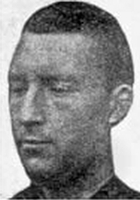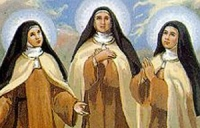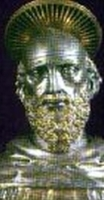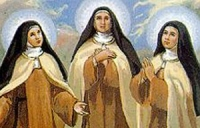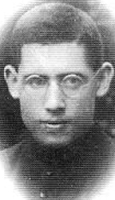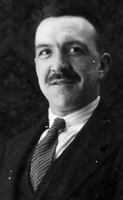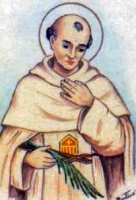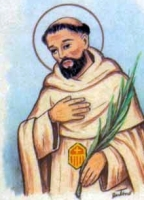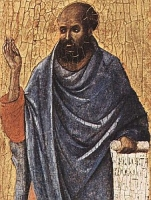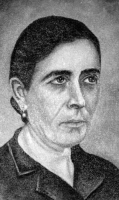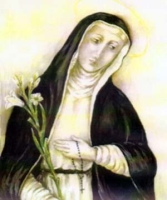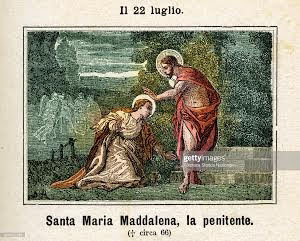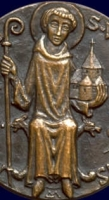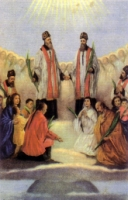St. Dictinus
Feastday: July 24
Death: 420
Bishop of Astorga, in Spain. He was originally a member of the Priscillianism heresy but was converted by St. Anibrose. Dictinus recanted at the Council of Toledo in 400.
Saint Christina the Astonishing
Also known as
Christina Mirabilis
Profile
Born to a peasant family, orphaned as a child, and raised by two older sisters. At age 21, she experienced a severe seizure of what may have been epilepsy. It was so severe as to be cateleptic, and she was thought to have died. During her funeral Mass, she suddenly recovered, and levitated to the roof of the church. Ordered down by the priest, she landed on the altar and stated that she had been to hell, purgatory, and heaven, and had been returned to earth with a ministry to pray for souls in purgatory.
Her life from that point became a series of strange incidents cataloged by a Thomas de Cantimpré, Dominican professor of theology at Louvain who was a contemporary who recorded his information by interviewing witnesses, and by Cardinal Jacques de Vitny who knew her personally. She exhibited both unusual traits and abilities. For example, she could not stand the odor of other people because she could smell the sin in them, and would climb trees or buildings, hide in ovens or cupboards, or simply levitate to avoid contact. She lived in a way that was considered poverty even in the 13th century, sleeping on rocks, wearing rags, begging, and eating what came to hand. She would roll in fire or handle it without harm, stand in freezing water in the winter for hours, spend long periods in tombs, or allow herself to be dragged under water by a mill wheel, though she never sustained injury. Given to ecstasies during which she led the souls of the recently dead to purgatory, and those in purgatory to paradise.
People who knew her were divided in their opinions: she was a holy woman, touched of God, and that her actions and torments were simulations of the experiences of the souls in purgatory; she was suffering the torments of devils; she was flatly insane. However, the prioress of Saint Catherine's convent testified that no matter how bizarre or excessive Christina's reported actions, she was always completely obedient to the orders of the prioresses of the convent. Christina was a friend of Louis, Count of Looz, whose castle she visited, and whose actions she rebuked. Blessed Marie of Oignies thought well of her, and Saint Lutgardis sought her advice.
Born
1150 at Brusthem near Liege, Belgium
Died
24 July 1224 at Saint Catherine's convent, Sint-Truiden, Belgium of natural causes
Beatified
• popular devotion existed and continues, but no formal beatification has taken place
• unknown if any cause is before the Congregation
• because of lack for formal designation, she is sometimes listed as Saint Christina, sometimes as Blessed Christina
Patronage
• against insanity, madness, mental disorders, mental handicaps or mental illness
• lunatics, mentally ill people
• mental health caregivers, professionals, psychiatrists and therapists
Blessed Giovanni Tavalli
Also known as
• Giovanni Tavelli
• Giovanni of Tossignano
Profile
While studying civil law in Bologna, Italy, Giovanni quit to join the Order of the Gesuati; in 1426, he was chosen prior of the Gesuati house in Ferrara, Italy. Chosen bishop of Ferrara on 28 October 1431. Giovanni at first refused the see, but Pope Eugene IV wrote to him about the matter, and the new bishop changed him mind. Ordained a priest and then consecrated bishop in a single continuous service on 27 December 1431; he served the remained 12 and a half years of his life.
Father Giovanni was an active bishop, travelling to all points of his diocese six times. He wrote and translated works on the ascetic life and the Bible. He attended the Council of Basel, and the Council of Ferrara-Florence. With the Marquises d’Este, in 1443 he founded the Arcispedale di Sant’Anna to provide for plague patients. Legend says that his prayers miraculously saved the city of Ferrara from the flooding of the river Po.
Born
latter 1386 in Tossignano, Bologna, Italy
Died
• 24 July 1446 in Ferrara, Italy of natural causes
• re-interred in the crypt of the church of San Girolamo in Ferrara in 1713
• relics enshrined in an urn and placed under the high altar of the church on 23 July 1719
• the urn was re-interred under the altar of the Crucifix in the church in 1947
• a bone from his right hand was donated to and enshrined in the archpriestal church of San Michele Arcangelo in Tossignano, Italy in August 1846
Beatified
• by Pope Clement VIII (cultus confirmation)
• by Pope Benedict XIV on 20 July 1748 (cultus confirmation)
• 23 January 2020 by Pope Francis (decree of heroic virtues following a re-examination of his Cause using the new methods and standards)
Blessed Cristóbal López de Valladolid Orea
Also known as
Cristóbal of Saint Catherine
Profile
One of six brothers born to a poor farming family. He was known as a pious child, and at age 7 or 8 he ran away from home, planning to join the Friars Minor; his mother sent his brothers to find him and bring him back. He served as an altar boy as often as he could, and when old enough he worked as a nurse in a hospital run by the Order of Saint John of God. Ordained a priest on 20 March 1663 in Badajoz, Spain. Military chaplain to the Spanish army that was fighting in Portugal, but ill health forced him to return home. In 1667 he became a hermit in the mountains of El Bañuelo, and after studying the teachings of Saint Francis of Assisi, he joined the Third Order Regular of Saint Francis in 1671, taking the name Cristóbal of Saint Catherine. Founded the Franciscan Hospitallers of Jesus the Nazarene in Córdoba, Spain on 11 February 1673 to care for the physical and spiritual needs of the sick; they received approval from Pope Benedict XIV in 1746. Father Cristóbal died holding a crucifix, a victim of cholera which he caught while tending to other patients during an epidemic.
Born
25 July 1638 at 8 Calle Baños, Mérida, Badajoz, Spain
Died
21 July 1690 in Córdoba, Spain of cholera
Beatified
• 7 April 2013 by Pope Benedict XVI; if was the first beatification of his papacy
• beatification recognition celebrated at the Cathedral of Córdoba, Spain, presided by Cardinal Angelo Amato
Patronage
Franciscan Hospitallers of Jesus of Nazareth
Saint Christina of Bolsena
Also known as
Christina Anicii
Profile
Born to a wealthy pagan family. Converted as a youth, she destroyed all the idols in her father's house; those of gold and silver she broke up and gave to the poor. Scourged, tortured, and martyred for her new faith.
Her story and that of Saint Christina of Tyre seem to have been confused and combined in rewrites through the ages.
Born
3rd century, probably at Rome, Italy into the family Anicii
Died
• c.250 near Lake Bolsena, Tuscany, Italy
• her father tied a rock around her neck, and threw her into Lake Bolsena
• when she miraculously survived, her tongue was cut out, and she was thrown into a furnace
• when she survived, she was shot full of arrows on the order of a magistrate persecuting Christians by order of Diocletian
• relics at Palermo, Sicily, and Torcelli
• head in the cathedral at Milan, Italy
Patronage
• archers
• mariners
• millers
Saint Charbel Makhlouf
தூய ஷார்பெல் மஹ்லூப்
பிறப்பு : 1828 ஷார்பெல், லெபனான் நாட்டில் உள்ள பே-குவா-கப்ரா
இறப்பு : 1898 ஆம் ஆண்டு இறையடி சேர்ந்தார்
புனிதர் பட்டம் : 1977 ஆம் ஆண்டு புனிதர் பட்டம் கொடுக்கப்பட்டது.
இவர் பிறந்த ஒருசில ஆண்டுகளிலே இவருடைய தந்தை இறந்து போனார்.
ஷார்பெல் சிறுவயது முதலே பக்தியில் சிறந்துவிளங்கி வந்தார். இவரிடமிருந்து விளங்கிய பக்தியைப் பார்த்துவிட்டு எல்லாரும் ஆச்சரியப்பட்டு நின்றார்கள். இவர் வளர்ந்து பெரியவராகிய போது மேபுங் என்னும் இடத்தில் இருந்த துறவற மடத்தில் சேர்ந்து, கல்விகற்று 1859 ஆம் ஆண்டு, குருவாக மாறினார்.
தன்னுடைய குருத்துவ வாழ்வின் பெரும்பாலான நாட்களை தனிமையிலும் ஜெபத்திலும் தவத்திலும் செலவழித்து வந்தார்; கடுமையான ஒறுத்தல் முயற்சிகளை மேற்கொண்டு வந்தார்.
தூய மரோன் என்பவரின் முன்மாதிரிகையைப் பின்பற்றி முன்பைவிட ஜெபத்திற்கும் தவத்திற்கும் ஒறுத்தல் முயற்சிகளுக்கும் முக்கியத்துவம் கொடுத்து வாழ்ந்து வந்தார். ஒருநாளைக்கு ஒருவேளை மட்டுமே உணவு உண்டு வந்தார். இப்படி அவர் கடுமையான ஒறுத்தல் முயற்சிகளைச் செய்து வந்ததால், அவருடைய உடல்நலம் குன்றியது. இதனால் அவர் படுத்த படுக்கையாகி இறையடி சேர்ந்தார்.
Also known as
Joseph Zaroun Makhlouf
Profile
Son of a mule driver. Raised by an uncle who opposed the boy's youthful piety. The boy's favorite book was Thomas a Kempis's The Imitation of Christ. At age 23 he snuck away to join the Baladite monastery of Saint Maron at Annaya where he took the name Charbel in memory of a 2nd century martyr. Professed his solemn vows in 1853. Ordained in 1859, becoming a heiromonk.
He lived as a model monk, but dreamed of living like the ancient desert fathers. Hermit from 1875 until his death 23 years later, living on the bare minimums of everything. Gained a reputation for holiness, and was much sought for counsel and blessing. He had a great personal devotion to the Blessed Sacrament, and was known to levitate during his prayers. Briefly paralyzed for unknown reasons just before his death.
Several post-mortem miracles attributed him, including periods in 1927 and 1950 when a bloody "sweat" flowed from his corpse. His tomb has become a place of pilgrimage for Lebanese and non-Lebanese, Christian and non-Christian alike.
Born
8 May 1828 at Beka-Kafra, Lebanon as Joseph Zaroun Makhlouf
Died
24 December 1898 at Annaya of natural causes
Canonized
9 October 1977 by Pope Paul VI
Saint Euphrasia
Also known asEufrasia, Eupraxia
Profile
Born to the Roman nobility, the daughter of Antigonus, senator of Constantinople. Related to Roman Emperor Theodosius I who finished the conversion of Rome to a Christian state. Her father died soon after Euphrasia was born; she and her mother became wards of the emperor.
When Euphrasia was only five years old, the emperor arranged a marriage for her to the son of a senator. Two years later, she and her mother moved to their lands in Egypt. There, while still a child, Euphrasia entered a convent; her mother died soon after of natural causes, leaving the novice an orphan.
At age twelve Euphrasia was ordered by the emperor Aracdius, successor to Theodosius, to marry the senator's son as arranged. Euphrasia requested that she be relieved of the marriage arrangement, that the emperor sell off her family property, and that he use the money to feed the poor and buy the freedom of slaves. Arcadius agreed, and Euphyrasia spent her life in the Egyptian convent.
Noted for her prayer life, and constant self-imposed fasting; she would sometimes spend the day carrying heavy stones from one place to another to exhaust her body and keep her mind off temptations. She suffered through gossip and false allegations, much of it the result of being a foreigner in her house. She is held up as a model by Saint John Damascene.
Born
380
Died
420 of natural causes
Blessed Josep Olivé Vivó
Also known as
• Bartolomeo della Passione
• Bartomé de la Pasión
• Bartomeu of the Passion
• José Olivé Vivó
Profile
Son of Magí Olivé Rovira and Antonia Vivó Montagut; his father died when Josep was still a little boy, and he grew up learning and running the family wine, almond and hazelnut business. As he grew into an adult, Josep felt a call to religious life, and when he was about 25 years old, he left the family business and joined the Discalced Carmelites at the convent in Tarragona, Spain. He made his profession on 25 November 1921, taking the name Bartolomeo della Passione.
Assigned to the Carmelite community in Badalona, Catalonia, Spain, in addition to the requirements of religious life, he worked as a bricklayer on the construction of the church and convent being built there. Led the founding of the Sanctuary of Santa Teresa del Niño Jesús, the first Carmelite community in Lleida, Spain in 1928. Served as secretary on the Carmelite magazine "Lluvia de Rosas". Martyred in the Spanish Civil War by militia units for the offense of being a Carmelite.
Born
14 September 1894 in Pla de Cabra, Tarragona, Spain
Died
24 July 1936 in Almacelles, Lleida, Spain
Beatified
• 13 October 2013 by Pope Francis
• beatification celebrated at the Complex Educatiu, Tarragona, Spain, Cardinal Angelo Amato presiding
Blessed Teresa of the Child Jesus and of Saint John of the Cross
Also known as
Eusebia García y García
Profile
Second of eight children born to Juan and Eulalia. As a child, she would often visit her uncle Florentino, a priest who was later martyred in the Spanish Civil War At age nine she made personal vows of chastity and devotion to the Blessed Virgin Mary, and in 1918 she moved to an Ursuline boarding school. Having read Story of a Soul by Saint Therese of Lisieux, she felt drawn to the Caremelite life, and on 2 May 1925 she became a Discalced Carmelite at the Carmel of San José de Guadalajara, taking the name Teresa of the Child Jesus and of Saint John of the Cross. Organist. Made her solemn vows on 6 March 1930. She spent her free time in Eucharistic adoration, "sunbathing" she said, in its light while she prayed for priests and conversions. Martyred in the Spanish Civil War. The mob that murdered her offered her freedom if she would say "Viva el Comunismo!" ("Long live Communism"); she answered "Viva Christo Rey!" (Long live Christ the King!).
Born
5 March 1909 at Mochales, Guadalajara, Spain
Died
shot and stabbed on the street by Communists on 24 July 1936 in Guadalajara, Spain
Beatified
29 March 1987 by Pope John Paul II
Saint Gleb
Also known as
Glev, David
Profile
Son of Saint Vladimir I of Kiev and Anne of Constantinople, Duke of Muscovy. Brother of Saint Boris; great-grandson of Saint Olga of Kiev.
After Vladimir's death, the kingdom was to have been divided among his sons, but their eldest half-brother, Svyatopolk, wished to rule alone. An army gathered to defend Boris, but he called them off, explaining that he could not raise a hand against his brother; Boris was soon killed by Svyatopolk's followers. Svyatopolk invited Gleb to Kiev, but on the way, his boat was boarded on the Dnieper River near Smolensk, and he was killed. In 1020 another of Vladimir's sons, Yaroslav, usurped Svyatopolk, and then buried the bodies of Boris and Gleb in the church of Saint Basil at Vyshgorod. Miracles were reported at their tomb, and it became a site of pilgrimage.
From the first, the highest motives were attributed to the brothers' resignation - unwillingness to repel injustice to themselves by force and violently oppose an elder brother. Not martyrs in the traditional sense, the Russian Church perceived them as "passion bearers" - blameless men who did not wish to die but refused to defend themselves, thus voluntarily submitting to death like Christ.
Died
stabbed in the throat between 1010 and 1015 (sources vary)
Canonized
1724 by Pope Benedict XIII (cultus confirmed)
Patronage
princes
Saint Kinga
Also known as
Cunegunda, Cunegunde, Cunegundes, Kioga, Kunegunda, Kunigunda, Kunigunde, Zinga
Profile
Daughter of King Béla IV of Hungary and Maria Laskarina; sister of Saint Margaret of Hungary and Blessed Jolenta of Poland; niece of Saint Elizabeth of Hungary; great-niece of Saint Hedwig of Andechs. Reluctant member of Polish royalty when she married Prince Boleslaus V, but it was a political marriage, and the pious couple lived as brother and sister; when Boleslaus became Prince of Cracow, became a princess of Poland. Noted for her charity to the poor and personal care for lepers. Founded a Poor Clare convent in Stary Sacz, Poland. Widowed in 1279, she gave away her wealth and retired to the convent as a prayerful Franciscan tertiary, turning her back completely on governance and worldly life.
Born
1224 in Buda, Hungary
Died
24 July 1292 in the convent at Stary Sacz, Malopolskie, Poland of natural causes
Beatified
• 11 June 1690 by Pope Alexander VIII (cultus confirmation)
• 3 July 1998 by Pope John Paul II (decree of heroic virtues after the Cause was re-opened)
Canonized
16 June 1999 by Pope John Paul II
Saint John Boste
புனிதர் ஜான் போஸ்ட்
(St. John Boste)
இங்கிலாந்து மற்றும் வேல்ஸ் நாடுகளின் நாற்பது மறைசாட்சிகளுள் ஒருவர்:
(Forty Martyrs of England and Wales)
பிறப்பு: கி.பி. 1544
வெஸ்ட்மோர்லேண்ட்
(Westmorland)
இறப்பு: ஜூலை 24, 1594
ஏற்கும் சமயம்:
ரோமன் கத்தோலிக்க திருச்சபை
(Roman Catholic Church)
முக்திபேறு பட்டம்: 1929
திருத்தந்தை பதினோராம் பயஸ்
(Pope Pius XI)
புனிதர் பட்டம்: 1970
திருத்தந்தை ஆறாம் பவுல்
(Pope Paul VI)
நினைவுத் திருநாள்: ஜூலை 24
புனிதர் ஜான் போஸ்ட், ஒரு ரோமன் கத்தோலிக்க திருச்சபையின் புனிதரும், இங்கிலாந்து மற்றும் வேல்ஸ் நாடுகளின் நாற்பது மறைசாட்சிகளுள் ஒருவருமாவார்.
ஜான் போஸ்ட், கி.பி. 1544ம் ஆண்டு, வடமேற்கு இங்கிலாந்தின் (north west England) “வெஸ்ட்மோர்லேண்ட்” (Westmorland) வரலாற்றுப் பிராந்தியத்தின் “டஃப்ஃபொன்” (Dufton) நகரிலே பிறந்தவராவார். நிலச்சுவான்தாரான இவரது தந்தையின் பெயர், “நிக்கோலஸ் போஸ்ட்” (Nicholas Boste) ஆகும். இவரது தாயாரின் பெயர், “ஜேனேட் ஹட்டன்” (Janet Hutton) ஆகும். இவர் “ஆப்பிள் கிராம்மர் பள்ளியிலும்” (Appleby Grammar School) “ஆக்ஸ்போர்டிலுள்ள” (குயின்ஸ் கல்லூரியிலும்” (Queen's College, Oxford) கல்வி கற்று இளங்கலை மற்றும் முதுகலை பட்டங்களை வென்ற இவர், அதே கல்லூரியிலேயே கி.பி. 1572ம் ஆண்டு ஒரு அங்கத்தினரானார். இரண்டு வருடங்களின் பின்னே, அரசி எலிசபெத்தின் சாசனத்தின் கீழே, தாம் கற்ற அதே “ஆப்பிள் கிராம்மர் பள்ளியின்” (Appleby Grammar School) தலைமை ஆசிரியராக பதவியேற்றார்.
கி.பி. 1576ம் ஆண்டு கத்தோலிக்கராக மனம் மாறிய இவர், இங்கிலாந்தை விட்டு வெளியேறி, கி.பி. 1581ம் ஆண்டு, மார்ச் மாதம், ஃபிரான்ஸ் நாட்டின் “கிரேண்ட் எஸ்ட்” (Grand Est) பிராந்தியத்தின் “ரெய்ம்ஸ்” (Reims) நகரில் குருத்துவ அருட்பொழிவு பெற்றார்.
கி.பி. 1581ம் ஆண்டு, ஏப்ரல் மாதமே இங்கிலாந்து திரும்பிய போஸ்ட், “டர்ஹாம்” (County Durham) மாகாணத்திலுள்ள “ஹர்ட்ல்பூல்” (Hartlepool) எனும் நகரில் இறங்கினார். அங்கிருந்து “ஈஸ்ட் ஏங்க்லியா” (East Anglia) நகர் சென்றார். லண்டனில் வந்திறங்கிய அவர் வடக்கிற்குத் திரும்புவதற்கு முன்பு “லார்டு மொண்டாகுட்” (Lord Montacute) என்பவரின் கத்தோலிக்கக் குடும்பத்தைச் சேர்ந்த ஒரு பணியாளராக நியமிக்கப்பட்டார். அவர் வடக்கு இங்கிலாந்தில் ஒரு மிஷனரி குருவாக பணியாற்றினார். அவருடன் “ஜான் ஸ்பீட்” (John Speed) என்பவர் அடிக்கடி பயணித்தார். (அக்காலத்தில், புனிதர் ஜான் போஸ்ட் மறைந்து வாழவும், அவர் தங்க கத்தோலிக்கர்களின் வீடுகளை ஏற்பாடு செய்து தந்தவருமான ஆங்கிலேய கத்தோலிக்க பொதுநிலையினரான “ஜான் ஸ்பீட்” (John Speed), மேற்கண்ட குற்றங்களுக்காக கி.பி. 1594ம் ஆண்டு, ஃபெப்ரவரி மாதம் 4ம் நாளன்று, “டர்ஹாம்” (Durham) நகரில் தூக்கிலிடப்பட்டு மறைசாட்சியாக கொல்லப்பட்டார். ரோமன் கத்தோலிக்க திருச்சபை இவரை கி.பி. 1929ம் ஆண்டு அருளாளராக உயர்த்தியது).
இவரது நடவடிக்கைகள், பெரும்பாலும் “லேடி மார்கரெட் நெவில்” (Lady Margaret Neville) என்பவருக்கு சொந்தமான, “டர்ஹாம்” (Durham) நகருக்கு அருகேயுள்ள “பிரன்ஸ்பீத் கோட்டையை” (Brancepeth Castle) மையமாக கொண்டே இருந்தன. ஒரு செயலூக்கமுடைய மிஷனரியான இவரைப் பிடிக்க அதிகாரிகள் மிகவும் ஆர்வமாக இருந்தனர். கி.பி. 1584ம் ஆண்டு, ஜனவரி மாதம், அரசால் நியமிக்கப்பட்ட உயர்நிலை ஆலோசகர்கள் சபை, அவரை கைது செய்ய ஆற்றல்மிக்க நடவடிக்கைகளை எடுக்க உத்தரவிட்டது. போஸ்ட்டின் சகோதரர் “லாரன்ஸ்” (Laurence) வீட்டில் தேடுதல் நடத்தப்பட்டது. “லார்டு ஹன்டிங்க்டன்” (Lord Huntingdon), இவரை வடக்கின் பெரிய கலைமான் என்று அழைத்தார்.
கி.பி. 1584ம் ஆண்டின் தொடக்கத்தில், “நார்தும்பெர்லேண்ட்” (Northumberland) செல்வதற்கு முன்னர், டிசம்பர் மற்றும் ஜனவரி மாதங்களில் “கார்லிஸில்” (Carlisle) நகரின் சுற்றுவட்டாரத்தில் தந்தை போஸ்ட் தோன்றினார். பத்து வருடங்கள் தாம் கைது செய்யப்படுவதை தவிர்த்துவந்த தந்தை போஸ்ட், முன்னாள் கத்தோலிக்கர் ஒருவரான “ஃபிரான்ஸ்சிஸ் எக்ல்ஸ்ஃபீல்ட்” (Francis Egglesfield) என்பவரால், கி.பி. 1593ம் ஆண்டு, காட்டிக்கொடுக்கப்பட்டார்.
“நெவில்” (Neville estate) தோட்டத்திலுள்ள “வாட்டர்ஹவுஸில்” (Waterhouse) ஒரு மாபெரும் வெகுஜன திருப்பலியை நிறைவேற்றிவிட்டு வெளியேறும்போது, தம்மை ஆசீர்வதிக்குமாறு தந்தை போஸ்டிடம் “ஃபிரான்ஸ்சிஸ் எக்ல்ஸ்ஃபீல்ட்” (Francis Egglesfield) கேட்டார். போஸ்ட் ஒப்புக் கொண்டபோது, இது அருகிலிருந்து கண்காணித்த படை வீரர்களுக்கு ஒரு அடையாள சமிக்ஞையாக இருந்தது. அவர்கள் வாட்டர்ஹவுஸை ஆக்கிரமித்தபோது, போஸ்ட் நெருப்புக்கு பின்னால் குருக்கள் மறைந்து வாழும் ஒரு துளையில் ஒளிந்திருந்தது கண்டுபிடிக்கப்பட்டது. அவர் கைது செய்யப்பட்டபின், “ரிச்சர்ட் டாப்கிலிஃப்” (Richard Topcliffe) என்பவரால், “லண்டன் கோபுரம்” (Tower of London) சிறைச்சாலைக்கு விசாரணைக்காக அழைத்துச் செல்லப்பட்டார். “டர்ஹாம்” (Durham) நகர் திரும்பிய அவர், அக்கால இங்கிலாந்து மற்றும் வேல்ஸ் நாடுகளில் குற்றவியல் மற்றும் சிவில் வழக்குகளை விசாரிக்கும் “அஸ்ஸிசெஸ்” (Assizes) என்றழைக்கப்படும் நீதிமன்றத்தினால் தண்டிக்கப்பட்டார். (1972ம் ஆண்டு, இந்த “அஸ்ஸிசெஸ்” (Assizes) நீதிமன்றங்கள் கலைக்கப்பட்டு, இவற்றின் சிவில் வழக்குகளை விசாரிக்கும் நடுவர் மன்றங்கள் உயர்நீதிமன்றத்துக்கும் (High Court), குற்ற விசாரணைகள் “கிரவுண்” அல்லது உச்சநீதிமன்றத்துக்கும்” (Crown Court) மாற்றப்பட்டன).
கி.பி. 1594ம் ஆண்டு, ஜூலை மாதம், 24ம் தேதி, “டிரைபர்ன்” (Dryburn) தூக்கிலிடப்பட்டார். இது தற்போது, “செயிண்ட் லியோனார்ட்” (St. Leonard's school) பள்ளியின் இடமாகும். போஸ்ட், தாம் ஒரு துரோகி என்பதை மறுத்தார். "என் செயல்பாடுகள், ஆன்மாக்களை கவர்வதற்காகத்தான். தற்காலிக படையெடுப்புகளில் தலையிட அல்ல" என்றார். படிக்கட்டுகளில் ஏறும்போதுகூட, ஜெபமாலை உருட்டியபடியேதான் ஏறினார். அசாதாரணமாக, மிருகத்தனமாக தாக்கப்பட்ட அவர், தூக்கிலிடப்பட்டார். துண்டு துண்டாக வெட்டப்பட்ட அவருடைய உடலின் பாகங்கள், கோட்டை சுவர்களின் தொங்கவிடப்பட்டன. அவருடைய தலை, “ஃபிரேம்வெல்கேட்” (Framwellgate Bridge) பாலத்தின் தூண் ஒன்றில் தொங்கவிடப்பட்டிருந்தது.
ஜூலை மாதம் 24ம் தேதி, இவர் நினைவுகூறப்படுகின்றார்.
Also known as
John Boast
Additional Memorial
• 25 October as one of the Forty Martyrs of England and Wales
• 29 October as one of the Martyrs of Douai
• 1 December as one of the Martyrs of Oxford University
Profile
Educated at Queen's College, Oxford, England from 1569 to 1572. Fellow at Queen's College. Convert to Catholicism in 1576 at Brome, Suffolk, England. Resigned his position at Oxford, and studied in Rheims, France in 1580. Ordained on 4 March 1581. Returned to England in April 1581 as a missioner to the northern counties, often disguised as a servant in the livery costume of Lord Montacute. Assisted in his mission by Blessed John Speed. He became the object of an intense manhunt, was betrayed by Francis Ecclesfield near Durham, England on 5 July 1593 at the home of one William Claxton, and arrested. He was sent to the Tower of London where he was crippled by being tortured on the rack. Sent to Durham in July 1594, where he was tried for the treason of being a priest. Martyr.
Born
c.1544 at Dufton, Westmoreland, England
Died
hanged, drawn, and quartered on 24 July 1594 at Dryburn near Durham, England
Canonized
25 October 1970 by Pope Paul VI
Blessed Balduino of Rieti
Also known as
Baldovino, Baldwin, Baudoin, Baudouin
Additioanl Memorials
• 21 August (city and diocese of Rieti, Italy; Bollandists)
• 15 July (Menologium Cisterciense)
Profile
Born to a pious noble family, the son of Berardo X, Count of Marsi; his brother Rainaold became abbot of Montecassino Abbey, and created cardinal by Pope Innocent II in 1138. Benedictine Cistercian monk at Clairvaux Abbey. Spiritual student of Saint Bernard of Clairvaux. Abbot of San Matteo di Montecchio monastery on Lake Montecchio in 1130. Abbot of the Saint-Sauveur monastery in the diocese of Rieti, Italy.
Born
Italy
Died
• 1140 of natural causes
• buried in the cathedral of Rieti, Italy
• some relics in the altar of the "delle Grazie" chapel of the cathedral
• skull housed in a silver reliquary bust depicting Blessed Baudoin that is one of several displayed at the high altar of the cathedral
Beatified
an Office with his history was approved by the Sacred Congregation of Rites in 1701
Saint Christina of Tyre
புனித கிறிஸ்டினா (மூன்றாம் நூற்றாண்டு)
இவர் தீர் என்ற பகுதியைச் சார்ந்தவர். இவரது தந்தை அப்பகுதியின் ஆளுநராக இருந்தார்.
கிறிஸ்டினாவின் குடும்பம் கிறிஸ்துவை அறியாத பிற இனத்தைச் சார்ந்த குடும்பமாக இருந்தது. பதினொரு வயதில்தான் இவர் கிறிஸ்துவை அறிந்து கொண்டார்.
இச்செய்தியைக் கேள்விப்பட்ட கிறிஸ்டினாவின் தந்தை, இவரை ஓர் அறைக்குள் அடைத்து வைத்து, அறை முழுவதும் பொன்னாலும் வெள்ளியாலும் செய்யப்பட்ட சிலைகளால் நிரப்பினார். அப்படியாவது இவர் கிறிஸ்துவை மறந்து, சிலைகளை வழிபடத் தொடங்குவார் என்று; ஆனால் இவர் அறையிலிருந்த பொன்னாலும் வெள்ளியாலும் செய்யப்பட்ட சிலைகளை உடைத்து, அவற்றை தனது அறைக்கு வெளியே இருந்த ஏழை எளிய மக்களுக்குக் கொடுத்தார்.
இதை அறிந்த இவரது தந்தை இவரைப் பல்வேறு விதமாகச் சித்திரவதை செய்தார். அப்படி இருந்தும் இவர் தன்னுடைய நம்பிக்கையில் உறுதியாக இருந்தார்.
கிறிஸ்டினாவின் தந்தை திடீரென இறந்து போனார். அப்பொழுது இவர் தன்னுடைய பிரச்சனையெல்லாம் முடிவுக்கு வந்துவிட்டது என நினைத்துக் கொண்டிக்க, இவரது தந்தைக்குப் பின் ஆளுநர் பதவியேற்றுக்கொண்ட தியோன், ஜூலியன் ஆகியோர் இவரை இன்னும் மிகுதியாகச் சித்திரவதை செய்தாரகள். அவர்களுடைய சித்திரவதை தாங்காமல் இவர் தன்னுடைய ஆவியை ஆண்டவரிடம் ஒப்படைத்தார்.
Profile
Young girl imprisoned for her faith. Her mother tried to argue her into making the required pagan sacrifices, but Christina refused, and was executed. Martyr.
Due to the details of her martyrdom, listed below, she's likely a pious fiction, but was highly honoured in Greece for centuries. Her story and that of Christina of Bolsena seem to have been confused and combined in rewrites through the ages.
Born
at Tyre
Died
• a fire was lit under her, raged out of control, killed hundreds of pagan bystanders, but Christina escaped unscathed
• her breasts were cut off, and then milk flowed from them
• her tongue was cut out; she continued to preach, louder, and more clearly and eloquently than ever
• she threw the severed tongue at the judge, who was permanently blinded in one eye
• she was thrown into the sea to drawn; there she was baptized by Jesus, then returned to land by Michael the Archangel
• she was finally shot through the heart with an arrow, which did her in
Blessed Maria Angeles of Saint Joseph
Also known as
Marciana Valtierra Tordesillas
Profile
Youngest of eleven children born to Manual and Lorenza; six of her siblings died in childhood. Her mother died when Marciana was three, and she decided to devote herself to the Blessed Virgin Mary as her new mother. She daily went to Mass, prayed the rosary, and spent hours in Eucharistic adoration. Worked with Father Juan Vicente of Jesus and Mary on the magazine La Obra Máxima (The Ultimate Work) and other projects. She was drawn to religious life, but the care of her father and other family members kept her at home for several years, but on 14 July 1929 she joined the Discalced Carmelites at the Carmel of San José de Guadalajara, taking the name María Angeles of Saint Joseph. Martyred in the Spanish Civil War.
Born
6 March 1905 at Getafe, Madrid, Spain
Died
shot and stabbed on the street by Communists on 24 July 1936 in Guadalajara, Spain
Beatified
29 March 1987 by Pope John Paul II
Blessed Jaume Baríau y Martí
Also known as
• Josep Oriol of Barcelona
• Giuseppe Oriol of Barcelona
Profile
Jaume joined the Capuchin Franciscan Friars Minor in 1906, making his solemn profession on 15 August 1911. Ordained a priest on 29 May 1915. Father Jaume taught liturgy, Hebrew and Church history in the seminary at Sarriá, Barcelona, Spain, living at the Franciscan convent in Manresa. While taking Communion to a Poor Clare nun, Father Jaume was spotted by Communist militiamen, identified as a priest, kidnapped, tortured and murdered. Martyred in the Spanish Civil War.
Born
25 July 1891 in Barcelona, Spain
Died
shot on 24 July 1936 just outside Manresa, Barcelona, Spain
Beatified
• 6 November 2021 by Pope Francis
• the beatification recognition was celebrated at the Basilica of Santa Maria in Manresa, Spain
Blessed Maria Mercedes Prat
Also known as
• Mercedes of the Sacred Heart
• Mercedes Prat y Prat
• Mercè Prat i Prat
• Maria Mercè of the Sacred Heart
Profile
Baptized on 7 March 1880, and made her First Holy Communion on 30 June 1890. She was a pious child who attended Mass nearly every day. Devoted student, a painter, and she excelled in needlework. Nun, entering the Society of Saint Teresa of Jesus in 1904 in Tortosa, Spain. Assigned to the motherhouse in Barcelona, Spain in 1920. On 19 July 1936 her community was forced by anti-Catholic government authorities to abandon their house and school. Mercedes was arrested and executed for the crime of being a nun.
Born
6 March 1880 in Barcelona, Spain as Mercedes Prat
Died
24 July 1936 at Barcelona, Spain of gun-shot wounds received on 23 July 1936
Beatified
29 April 1990 by Pope John Paul II
Blessed Maria Pilar of Saint Francis Borgia
Also known as
Jacoba Martínez García
Profile
Youngest of eleven children born to Gabino Martinez and Luisa Garcia; eight of her siblings died in childhood; her surviving siblings became a priest and a Carmelite nun. Jacoba joined the Discalced Carmelites at the San José de Guadalajara convent on 12 October 1898, taking the name María Pilar of Saint Francis Borgia, making her profession on 15 October 1899. A seamstress and lace maker, noted for her skill in embroidery; she devoted all her needle work efforts to the glory of God. Sacristan of her house. Martyred in the Spanish Civil War.
Born
30 December 1877 at Tarazona, Zaragoza, Spain
Died
shot and stabbed on the street by Communists on 24 July 1936 in Guadalajara, Spain
Beatified
29 March 1987 by Pope John Paul II
Blessed Joseph Lambton
Additional Memorial
• 29 October as one of the Martyrs of Douai
• 22 November as one of the Martyrs of England, Scotland, and Wales
Profile
Second son of Thomas Lambton of Malton-in-Rydall, Yorkshire, England, and Katharine, daughter of Robert Birkhead of West Brandon, Durham, England. Joseph studied at the English College in Reims, France beginning in 1584, then at the English College in Rome, Italy beginning in 1589. Ordained in 1591. He and Blessed Edward Waterson returned to England to minister to covert Catholics on 22 April 1592 during the persecutions of Queen Elizabeth I but were almost immediately arrested, imprisoned and executed for the crime of being a priest. Martyr.
Born
1568 in Malton, North Yorkshire, England
Died
hanged, drawn and quartered on 24 July 1592 in Newcastle, Tyne and Wear, England
Beatified
22 November 1987 by Pope John Paul II
Blessed Cecilio Vega Domínguez
Also known as
Caecilius
Additional Memorial
28 November as one of the Oblate Martyrs of the Spanish Civil War
Profile
Born to a poor but pious farm family, one of nine children born to Juan and Micaela. Joined the Missionary Oblates of Mary Immaculate on 14 August 1930, and made his perpetual vows on 23 December 1934. Studied in Pozuelo, Spain. Sub-deacon studying for the priesthood when he was martyred in the Spanish Civil War.
Born
8 September 1913 in Villamor de Órbigo, diocese of Astorga, León, Spain
Died
shot at dawn on 24 July 1936 in Pozuelo de Alarcon, Madrid, Spain
Beatified
17 December 2011 by Pope Benedict XVI
Saint Arnulf of Gruyere
Also known as
Arnulfus, Arnulphus
Profile
A pious youth. As soon as he was old enough, Arnulf left home to make an endless pilgrimage to shrines and relics throughout France. While on the road, he was beset by thieves who were certain he was hiding money; he wasn't. They beat him to the point that he lived long enough to be brought to the town of Gruyere, France and receive Communion one last time.
Born
Lorraine (in modern France)
Died
• beaten to death with sticks in a forest in Gruyere, Champagne, France
• relics re-discovered and enshrined in Mouzon, Champagne, France in 901
Saint José Fernández de Ventosa
Also known as
Joseph Fernandez
Additional Memorial
24 November as one of the Martyrs of Vietnam
Profile
Dominican priest. Missionary to Vietnam in 1805. Provincial vicar at Tonkin. Martyr.
Born
3 September 1775 at Ventosa de la Cueva, ávila, Spain
Died
beheaded on 24 July 1838 in Nam Ðinh, Vietnam
Canonized
19 June 1988 by Pope John Paul II
Blessed Donatus of Urbino
Also known as
Donato
Profile
Born to a wealthy and socially prominent family, the son of a lawyer. Studied at the University of Padua. Physician. Franciscan friar. Franciscan Provincial for the Marches on five separate occasions.
Born
15th century in Urbino, Italy
Died
• 1504 in the Franciscan monastery of San Bernardino, Urbino, Italy of natural causes
• interred under the altar of the monastery church
Blessed Louise of Savoy
Also known as
Luisa
Profile
Born to the nobility, the daughter of Blessed Amadeus IX, the duke of Savoy. Cousin of Saint Joan of Valois. Married to Hugh of Châlons in 1479. Widowed in 1489. Joined the Poor Clares at Orbe (in modern Switzerland), and was assigned to beg food for her house.
Born
28 December 1462
Died
1503 of natural causes
Beatified
1839 by Pope Gregory XVI (cultus confirmed)
Saint Declan of Ardmore
Also known as
Déaglán
Profile
A convert, he was baptized by and became a spiritual student of Saint Colman. Monk. Trained as an evangelist by Saint Diomma of Kildimo. Worked in Ireland before the arrival of Saint Patrick. Pilgrim to Rome, Italy. First bishop of Ardmore, Waterford, Ireland. Known as a miracle worker.
Born
5th century at Desi, Waterford, Ireland
Patronage
• Ardmore, Ireland
• diocese of Waterford and Lisman, Ireland
Blessed Cándido Castán San José
Additional Memorial
28 November as one of the Oblate Martyrs of the Spanish Civil War
Profile
Married layman. Martyr.
Born
5 August 1894 in Benifaió, Valencia, Spain
Died
shot on 24 July 1936 in Pozuelo de Alarcon, Madrid, Spain
Beatified
17 December 2011 by Pope Benedict XVI
Blessed Xavier Bordas Piferrer
Profile
Born to a pious family. Joined the Salesians in 1932. Studied at the Gregorian University in Rome, Italy. Priest. Martyred in the Spanish Civil War.
Born
4 September 1914 in San Pol de Mar, Barcelona, Spain
Died
shot on 23 July 1936 in Sarria, Barcelona, Spain
Beatified
11 March 2001 by Pope John Paul II
Blessed Robert Ludlam
Additional Memorials
• 29 October as one of the Martyrs of Douai
• 22 November as one of the Martyrs of England, Scotland, and Wales
Profile
Priest in the apostolic vicariate of England. Martyred in the persecutions of Queen Elizabeth I.
Born
c.1551 in Radborne, near Derby, Derbyshire, England
Died
24 July 1588 in Derby, Derbyshire, England
Beatified
22 November 1987 by Pope John Paul II
Blessed Richard Simpson
Memorial
• 29 October as one of the Martyrs of Douai
• 22 November as one of the Martyrs of England, Scotland, and Wales
Profile
Priest in the apostolic vicariate of England. Martyred in the persecutions of Queen Elizabeth I.
Born
c.1554 in Well, near Ripon, North Yorkshire, England
Died
24 July 1588 in Derby, Derbyshire, England
Beatified
22 November 1987 by Pope John Paul II
Blessed Nicholas Garlick
Memorial
• 29 October as one of the Martyrs of Douai
• 22 November as one of the Martyrs of England, Scotland, and Wales
Profile
Priest in the apostolic vicariate of England. Martyred in the persecutions of Queen Elizabeth I.
Born
c.1555 in Dinting, Derbyshire, England
Died
24 July 1588 in Derby, Derbyshire, England
Beatified
22 November 1987 by Pope John Paul II
Blessed José Máximo Moro Briz
Profile
Priest in the diocese of ávila, Spain. Martyred in the Spanish Civil War.
Born
29 May 1882 in Santibáñez de Béjar, Salamanca, Spain
Died
24 July 1936 in the Cebreros highway, El Tiemblo, ávila, Spain
Beatified
• 27 October 2013 by Pope Francis
• beatification recognition celebrated at Tarragona, Spain
Blessed Paulus Yi Do-gi
Additional Memorial
20 September as one of the Martyrs of Korea
Profile
Layman martyr in the apostolic vicariate of Korea.
Born
1743 in Cheongyang, Chungcheong-do, South Korea
Died
24 July 1798 in Jeongsan, Chungcheong-do, South Korea
Beatified
15 August 2014 by Pope Francis
Saint Boris of Kiev
Also known as
Romanus
Profile
Son of Saint Vladimir, Duke of Muscovy. Grandson of Saint Olga of Kiev. Brother of Saint Gleb. Martyr.
Died
1010
Canonized
1724 by Pope Benedict XIII (cultus confirmed)
Patronage
• Moscow, Russia
• princes
• Russia
Blessed Pierre de Barellis
Profile
Born to the French nobility. Mercedarian friar. Served as the attorney general of his Order. Papal legate. Created cardinal-deacon by Pope Nicholas IV.
Died
• Ascoli Piceno, Italy of natural causes
• buried in Ascoli Piceno
Blessed Juan Solorzano
Profile
Mercedarian friar in Fuentes, Spain. Missionary, sailing to Cuba with Christopher Columbus. There he converted many and built several monasteries. Martyr, possibly the first Christian killed for his faith in the New World.
Died
c.1500 in Cuba
Saint Rainofle
Also known as
Rainofre, Ragnulph
Profile
Relative of Pepin, Mayor of the Palace to King Dagobert, and a member of the Dagobert court. Wishing to devote herself to God, she fled the court to avoid an arranged marriage and died from exposure.
Died
• from exposure in modern France
• relics venerated in Aincourt, France
Blessed Diego Martinez
Profile
Mercedarian friar in Spain. Came to the Americas with Francisco Pizarro and Diego de Almagro. Missionary in Panama, and then in Cuzco, Peru. Martyr.
Died
1536 in Peru
Saint Godo of Oye
Also known as
Gaon
Profile
Nephew and spiritual student of Saint Wandrille. Benedictine monk under Wandrille at Fontenelle Abbey. Founder and abbot of Oye Abbey at Sezanne-en-Brie, France.
Born
at Verdun, France
Died
c.690 of natural causes
Saint Rufinus of Mercia
Also known as
Ruffin of Mercia
Profile
Seventh century prince, born to the royal family of Mercia, England. Baptised by Saint Chad. Murdered by his pagan father. Martyr.
Died
at Stone, Staffordshire, England
Saint Cyriacus of Ziganeos
Profile
One of seven Christian brothers who were soldiers in the imperial Roman army. Kicked out of the military, exiled and eventually martyred in the persecutions of Maximian.
Died
c.311 at Ziganeos
Saint Sigolena of Trocar
Also known as
Segoulème
Profile
Born to the nobility of Aquitaine (in modern France). Married. Widow. Nun and later abbess at Troclar Convent in southern France.
Died
c.769
Saint Wulfhad of Mercia
Profile
Seventh century prince, born to the royal family of Mercia, England. Baptised by Saint Chad. Murdered by his pagan father. Martyr.
Died
at Stone, Staffordshire, England
Saint Christiana
Also known as
Christine
Profile
Anglo-Saxon princess. Nun in Flanders, Belgium.
Born
7th century England
Died
Flanders, Belgium
Patronage
Termonde, Belgium
Saint Victorinus of Amiterno
Profile
Martyr.
Died
on the Via Salaria, Amiterno, Italy
Saint Lewina of Seaford
Profile
Fifth-century nun, martyr by pagan Saxon invaders, and venerated in Seaford, Sussex, England.
Born
British Isles
Saint Aliprandus of Pavia
Also known as
Leuprandus
Profile
Eighth century abbot of Saint Augustine's Abbey in Pavia, Italy.
Saint Ursicinus of Sens
Profile
Bishop of Sens, France. Fought Arianism in his diocese.
Died
c.380
Saint Menefrida
Profile
No details have survived.
Died
5th century
Patronage
Tredresick, Cornwall, England
Saint Antinogenes of Merida
Profile
Martyr.
Died
304 in Merida, Estremadura, Spain
Saint Stercatius of Merida
Profile
Martyr.
Died
304 in Merida, Estremadura, Spain
Saint Aquilina the Martyr
Profile
Sister of Saint Niceta. Third-century convert. Martyr.
Saint Victor of Merida
Profile
Martyr.
Died
304 in Merida, Estremadura, Spain
Saint Vincent of Rome
Profile
Martyr.
Died
outside the walls of Rome, Italy








